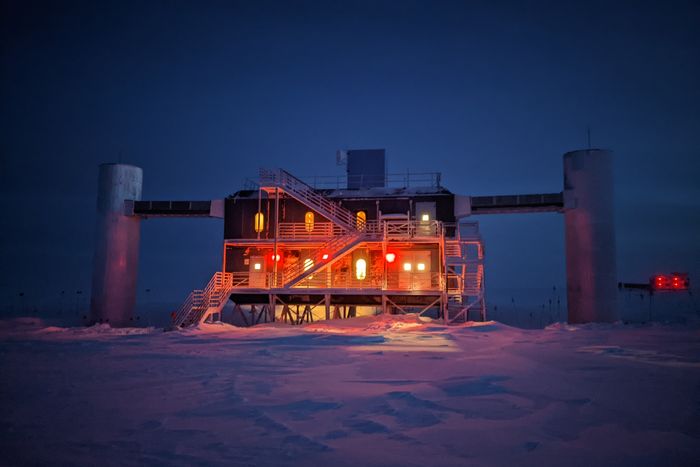A giant observatory buried in the ice of Antarctica helped scientists track its trace The elusive particles are called neutrinos Returning to their origins in the heart of a nearby galaxy – providing a new way to study a supermassive black hole hidden from view.
according to A new study was published Thursday In Science, neutrinos are accelerating toward Earth from the center of a spiral-shaped galaxy known as Messier 77, which is about 47 million light-years from Earth. There, a region of dense matter and radiation surrounds a black hole millions of times as massive as our Sun.
The celestial core of Messier 77 is located in such a way that dust and gas orbiting the black hole obscure the object when viewed from Earth using typical methods such as telescopes that rely on optical light.
“We see the galaxy a little sideways, and because we’re looking at it from the side, the black hole is hiding behind the material orbiting near it,” said Ignacio Taboada, a professor of physics at the Georgia Institute of Technology. A spokesperson for the international cooperation who conducted the research.
But neutrinos – the most abundant and energetic particles in the universe –Pass through this gas and dust unaffected Because they rarely interact with anything, including magnetic fields, matter, or gravity. This phantom aspect provides scientists with an unprecedented way to probe the processes occurring around a previously hidden black hole, including how super-charged gases and matter accelerate into the vicinity, the researchers said.
“Neutrinos are a different way of looking at the universe. And every time you look at the universe in a new way, you learn something that you would not have learned in the old ways,” said Dr. Tabouda.
One of more than 5,000 sensors collecting data at the IceCube Neutrino Observatory in Antarctica.
picture:
Mark Krasberg, IceCube/NSF
Neutrinos preserve information They are imprinted when formed in their sources, including their energies, according to Hans Niederhausen, a postdoctoral fellow at Michigan State University who was involved in the research. This same energy is brought to Earth with neutrinos.
Now that they know where some of the neutrinos come from, researchers are studying them to better understand where the interactions within Messier 77 that create and speed up these particles occur — and the behavior and nature of the black hole itself, said Dr. Niederhausen.
They also plan to comb the universe for other neutrinos from galaxies with active supermassive black holes similar to Messier 77. This galaxy “gives us a very good idea of where to look next,” he added.
The neutrino-detecting telescope used in the study, known as the Ice Cube Neutrino ObservatoryBuried in a billion tons of ice around the Amundsen-Scott South Pole station in the US. When neutrinos pass through Earth, they sometimes collide with atoms in the ice. The observatory detects more than 5,000 basketball-sized sensors byproducts of those rare collisions and sends that data to computers on the surface.
The $279 million observatory, funded primarily by the National Science Foundation, was completed in 2011 and detects approximately 100,000 neutrinos annually. Almost all of these neutrinos are created by processes in our atmosphere, but a few hundred or so of the neutrinos detected annually originate from outside our solar system – known as astrophysical neutrinos.

The laboratory that houses computers that collect data from sensors under the Antarctic ice.
picture:
Moreno Parisevich, IceCube / NSF
Because Neutrinos penetrate matter And they pass through unaffected, traveling without error in a straight line from their point of creation. So, by plotting the direction of physical neutrino transmission through the ice, researchers can reconstruct its path through the universe to its source.
Nearly 400 scientists in more than 50 institutions constitute the international IceCube cooperation, which analyzed data Collected by Observatory Between 2011 and 2020 to identify 79 neutrinos originating from Messier 77.
Dr Yoshi Uchida, a professor of physics at Imperial College London who was not involved in the study, said IceCube’s discovery of individual objects that are astrophysical neutrino sources is “quite amazing”. “After running for 10 years, it turns observing neutrinos into another source of information.”
Dr. Tapoada said he believes the IceCube will continue to get more neutrinos emerging from this galaxy. Not only could these future discoveries help analyze additional details about Messier 77’s supermassive black hole, but they could help answer “the oldest question in astronomy,” according to Frances Halzen, a physicist at the University of Wisconsin-Madison and principal investigator at IceCube.
Scientists have known about the existence of cosmic rays – streams of high-energy protons and atomic nuclei that travel at speeds close to light and produce electromagnetic radiation and a barrage of subatomic particles when they strike Earth’s atmosphere – for more than a century. But the origin of these rays, and what is the mechanism that accelerates them and sends them in our direction, remains elusive.
“Something in the universe gave them a huge boost to make them go so fast,” Dr. Niederhausen said of cosmic rays.
Neutrinos are a byproduct of those cosmic rays’ interactions with matter and radiation surrounding high-energy objects like supermassive black holes, so Dr. Tracing the ghostly particles back to their inception could help solve the origins of cosmic rays, Halzen and Taboada said.
Write to Aylin Woodward at [email protected]
Copyright © 2022 Dow Jones & Company, Inc. all rights are save. 87990cbe856818d5eddac44c7b1cdeb8

“Reader. Infuriatingly humble coffee enthusiast. Future teen idol. Tv nerd. Explorer. Organizer. Twitter aficionado. Evil music fanatic.”
